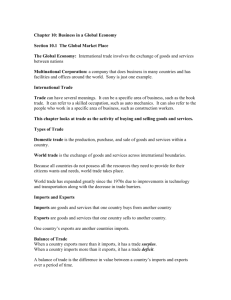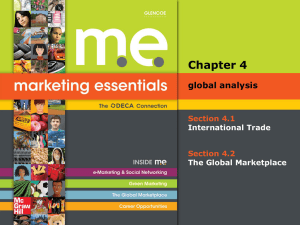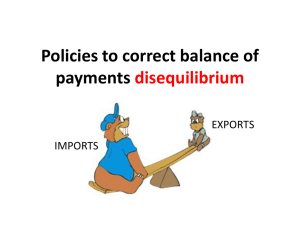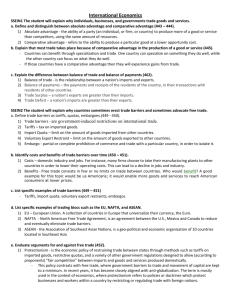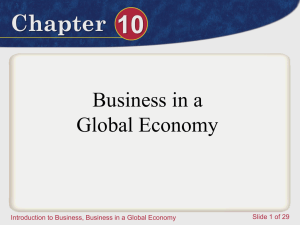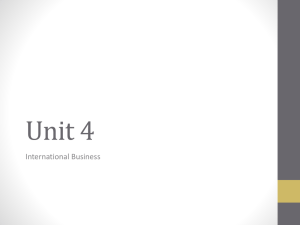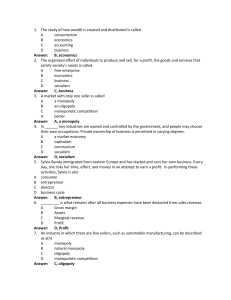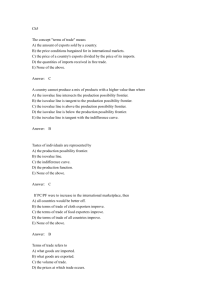Completing in Global Markets
advertisement
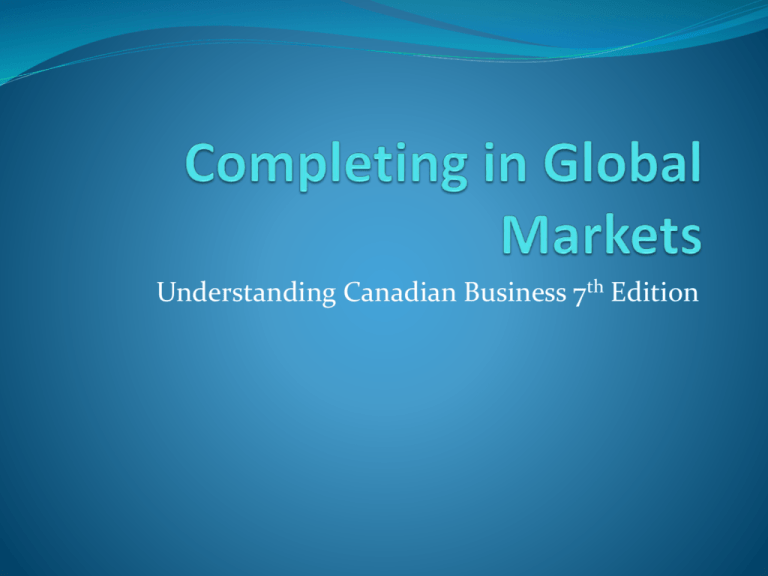
Understanding Canadian Business 7th Edition The Dynamic Global Market Canada has a market of 33.6 million people. 6.8 billion potential customers in 195 countries that make up the global market. Exporting – is selling goods and services to another country. Importing – is buying goods and services from another company Why trade with Other Nations? 1. No country, not even a technologically advanced one, can produce all of the products that its people want and need. 2. Even if a country was self-sufficient, other nations would seek to trade with that country to meet the needs of their own people. 3. Some nations have an abundance of natural resources and a lack of technological know-how, while others countries have sophisticated technology but few natural resources. Free Trade Free trade is the movement of goods and services among nations without political or economic trade barriers. Comparative advantage theory states that a country should sell to other countries those products that it produces most efficiently and buy from those countries those products that it cannot produce as effectively or efficiently. Absolute advantage – the advantage that exists when a country has the ability to produce a particular good or service using fewer resources than another country. https://www.youtube.com/watch?v=7njIlZ2xYq0 Pros of Free Trade The global market contains more than 6 billion potential customers for goods and services. Productivity grows when countries produce goods and services in which they have a comparative advantage. Global competition and less-costly imports keep prices down, so inflation does not curtail economic growth Free trade inspires innovation for new products and keeps firms competitively challenged. Uninterrupted flow of capital gives countries access to foreign investments, which help keep interest rates low. Cons of Free Trade Domestic workers can lose their jobs due to increased imports or production shifts to low-wage global markets. Workers may be forced to accept pay cuts from employers who can threaten to move their jobs to lower-cost global markets. Moving operations overseas because of intense competitive pressure often means the loss of service jobs and whitecollar jobs. Domestic companies can lose their competitive advantage when competitors build advanced production operations in low-wage countries Getting involved in Global Trade Imports for goods and services reached 529.4 billion in 2008. Services represented 16.3 percent of total imports, or almost 1 out of every 6 dollars of total imports. In merchandise trade (machinery and equipment, industrial goods and material and automotive products) represent almost 65 percent of imports Exporting Goods and Services Exports alone account for one in five jobs and generate 30 cents out of every dollar earned. Just think of all the music we have exported: Nickelback, Avril Lavigne, Celion Dion 73.5% of our exports are with the US and 68.8% of our imports are with the US https://www.youtube.com/watch?v=bMHA5FOKxs4 Strategies for Reaching Global Markets Exporting – the simplest way to going international is to export your goods and services. Specialist called export-trading companies are available to step in and negotiate and establish the trading relationship desired. Licensing –a global strategy in which a firm (a licensor) allows a foreign company (the licensee) to produce its product in exchange for a fee( a royalty eg. Disney, Coca-cola, PepsiCo. More strategies Franchising –is an arrangement whereby someone with a good idea for a business sells the rights to use the business name and sell a product or service to others in a given territory. Eg McDonald’s , KFC Contract Manufacturing – involves a foreign company’s production of private –label goods to which a domestic company then attaches its own brand name or trademark; also called outsourcing. Eg Dell Measuring Global Trade Balance of trade – is a nation’s ration of exports to imports. A favorable balance of trade occurs when the value of a country’s exports exceeds that of its imports. Unfavorable balance of trade or trade deficit occurs when the value of the country’s imports exceeds it exports. Balance of payments is the difference between money coming into the country and money leaving the country plus money flows coming into the country from other factors such as tourism, foreign aid, military expenditures, and foreign investment. International Joint Ventures and Strategic Alliances Joint venture- is basically a partnership in which two or more companies( often from different countries) join to undertake a major project or to form a new company. Eg GM and volkswagen Strategic alliance – a long term partnership between two or more companies established to help each company build competitive market advantages. Foreign Direct Investment Foreign Direct Investment is the buying of permanent property and businesses in foreign nations. Foreign subsidiary – is a company that is owned in a foreign country by another company (called a parent company). Multinational corporation – is an organization that manufactures and markets products in many different countries and has multinational stock ownership and multinational management. Eg Nestle Forces Affecting Trading in Global Markets Sociocultural Forces Culture – the set of values, beliefs, rules, and institutions held by a specific group of people. Ethnocentricity – an attitude that one’s own culture is superior to all others. Successful companies are those that can understand these differences and develop goods and services accordingly Problems with Cultural Differences In Latin American companies, workers believe that managers are placed in positions of authority to make decisions and be responsible for the well being of their workers. PepsiCo attempted a Chinese translation of “Come Alive, You’re in the Pepsi Generation” that read to Chinese customer’s as “Pepsi Brings Your Ancestors Back from the Dead”. More Problems with Translations Coor’s Brewing Company put its slogan “Turn it Loose” into Spanish and found it translated as “Suffer from Diarhea” KFC’s patented slogan “finger-lickin good” was understood in Japanese as “Bite Your Fingers Off.” https://www.youtube.com/watch?v=GMWio6MW9KY Economic Forces Exchange rate – the value of one nation’s currency relative to the currencies of other countries. A high value fo the dollar means that the dollar would be traded for move foreign currency than normal. The products of foreign producers would be cheaper but the cost of Canadian goods would be more expensive for foreign purchasers. Economic Forces (continued) Devaluation – is the lowering the value of a nation’s currency relative to other currencies. Countertrading – a complex form of bartering in which several countries may be involved, each trading goods for goods and services for services. Legal and Regulatory Forces In any economy, both the conduct and the direction of businesses are firmly tied to the legal and regulatory environment in Canada. Eg bribery in other countries Technological Forces Certain technological forces can also have an important impact on a company’s ability to conduct business in global markets. Eg Computer and Internet usage in developing countries. Trade Protectionism Trade protectionism is the use of government regulations to limit the import of goods and services. Dumping is the practice of selling products in a foreign country at lower prices than those charged in the producing country. Tariff- a tax imposed on imports More Trade Definitions Import Quota – limits the number of products in certain categories that a nation can import. Embargo- is a complete ban on the import or export of certain product or the stopping of all trade with a particular country. The GATT and the WTO GATT (General Agreement on Tariff and Trade)- a 1948 agreement that established an in trade restrictions. WTO (World Trade Organization) – the international organization that replaced the General Agreement on Tariffs and Agreement on Tariffs and Trade, and was assigned the duty to mediate trade disputes among nations The IMF and the World Bank International Monetary Fund (IMF) is an international bank that makes short term loans to countries experiencing problems with their balance of trade. World Bank (International Bank for Reconstruction and Development) an autonomous UN agency that borrows money from the more prosperous countries and lends it to less-developed countries to develop their infrastructure Producer’s Cartels Organizations of commodity-producing countries that are formed to stabilize or increase prices to optimize overall profits in the long run. Eg OPEC – organization of the petroleum exporting countries Common Markets Also called a trading bloc is a regional group of countries that have a common external tariff, no internal tariffs, and the coordination of laws to facilitate exchange among member countries. Eg NAFTA and EU NAFTA North American Free Trade Agreement (NAFTA) which created a free-trade area among Canada, the United States and Mexico. Objectives of NAFTA 1. Eliminate trade barriers and facilitate cross-border movement of goods an services among the three countries. 2. Promote conditions of fair competition in this free trade area NAFTA continued 3. Increase investment opportunities in the territories of the three nations 4.Provide effective protection and enforcement of intellectual property rights in each nation’s territory 5.establish a framework for further regional trade cooperations 6. Improve working conditions in NA The European Union (EU) The EU is a group of 27 member nations located primarily in Europe. 1999 the EU officially launched its joint currency, the euro
